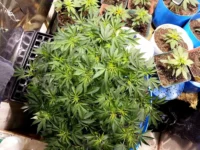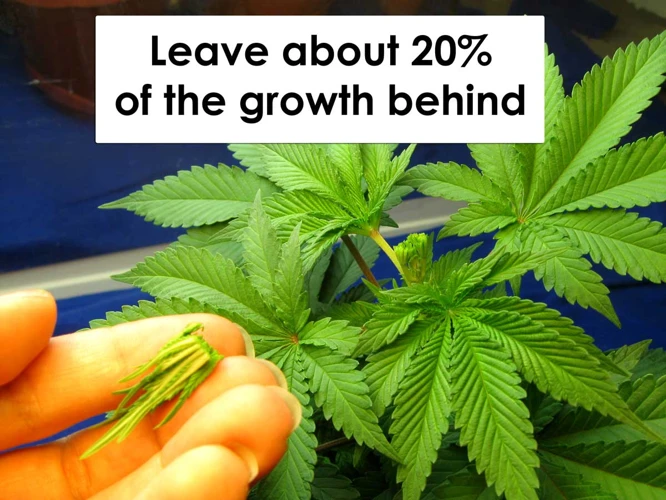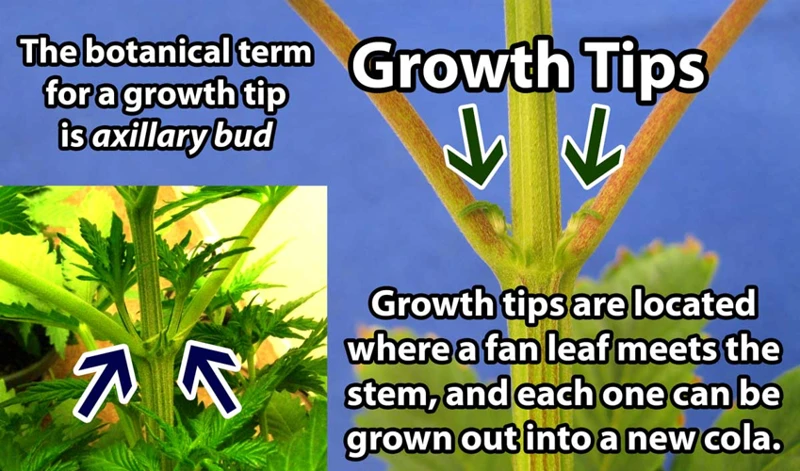
FIMming Cannabis Plants: A Complete Guide
Growing cannabis plants can be an exciting journey, and to achieve its full potential, it requires proper care and attention. One of the techniques that can help improve the yield of your cannabis plant is “FIMming.” Although FIMming may sound like a daunting process, it is a simple technique that can help increase the number of colas from each plant. In this article, we’ll explore the steps involved in FIMming your cannabis plants and outline the benefits and aftercare needed to ensure a successful FIM. If you’re ready to learn how to FIM your cannabis plants, let’s dive into this guide.
What is FIMming?
Contents
If you’re new to growing cannabis, you may have heard the term “FIMming” and wondered what it means. FIMming is a type of pruning technique that involves selectively trimming the top of a cannabis plant to encourage bushier growth. This method can be confusing for beginners, but with a bit of knowledge and practice, it can help increase your cannabis yield and improve the overall health of your plants. Let’s dive into the details and understand what FIMming is all about.
The Benefits of FIMming Cannabis
FIMming, or “FIM” for short, has become a popular technique among cannabis growers due to its many benefits for the plants. Here are some of the key advantages of FIMming your cannabis plants:
- Increased Yield: One of the main benefits of FIMming is increased yield. By removing the top portion of the plant, the lower branches are able to grow faster and stronger, resulting in a fuller and bushier plant with more colas (flowering sites).
- Improved Plant Structure: FIMming helps to improve the overall structure of the plant. By removing the main growth tip, the lower branches are encouraged to grow more horizontally, resulting in a wider and more even canopy. This improves the distribution of light to all the flowering sites, resulting in bigger buds.
- Faster Recovery: FIMming is less traumatic to the plant than topping, and allows for faster recovery time. The plant is able to redirect its growth hormones to the remaining branches, allowing them to develop faster and stronger.
- Less Stress: FIMming is less stressful to the plant than topping because it only removes a portion of the growth tip, rather than the entire thing. This reduces the risk of shock or stunted growth, resulting in healthier plants overall.
In addition to these benefits, FIMming also allows for better control over the height of the plant, making it an ideal technique for indoor growers who may have limited space. However, it’s important to note that FIMming should only be done during the vegetative stage of growth, as it can cause damage to the plant if done later on. FIMming is a highly effective method for increasing yield and improving the quality of your cannabis plants, making it a valuable tool for any grower to have in their arsenal.
When to FIM your Plants
Determining the right time to FIM your cannabis plants can be a perplexing task for beginners. It is essential to understand the growth cycle of your cannabis plants and to identify when they are ready to be FIMmed. Timing is crucial when it comes to this technique as incorrect FIMming can lead to stress and decreased yield. In this section, we will discuss the factors to consider when determining the appropriate time to FIM your plants, including the physical characteristics of FIM-able plants and how to prepare your plants for FIMming. By the end of this section, you will have a clear understanding of when and how to FIM your cannabis plants.
What does a FIM-able Plant Look Like?
To successfully FIM a cannabis plant, it is crucial to identify a plant that can be FIMmed. Not all plants are suited for FIMming, and attempting to do so on an unsuitable plant could lead to stunted growth or even plant death. A FIM-able plant will have certain characteristics that make it suitable for this technique.
What does a FIM-able Plant Look Like?
To identify a FIM-able plant, there are a few key features to look out for. First, the plant should have at least three to four nodes, or sets of leaves, with each node having a new set of leaves emerging. This indicates that the plant is actively growing and has enough leaf material to recover from the FIMming process.
Another important characteristic of a FIM-able plant is a strong, healthy stem. Look for a plant with a sturdy stem and thick branches. This will allow the plant to support new growth after the FIMming process.
Finally, choose a plant with a symmetrical canopy. This means that the plant has an even distribution of branches and leaves, allowing for an even growth response after FIMming.
To make it easier to identify a FIM-able plant, see the table below for a summary of the characteristics to look out for:
| Characteristic | Description |
|---|---|
| Nodes | Plant should have at least three to four nodes with new leaves emerging |
| Stem | Plant should have a sturdy stem and thick branches |
| Canopy | Plant should have an even distribution of branches and leaves |
Remember, it is important to be selective when choosing plants for FIMming. Taking the time to identify a FIM-able plant will increase your chances of success and ultimately lead to a healthier, more productive cannabis plant.
How to Prepare your Plant for FIMming
Preparing your cannabis plant for FIMming is a crucial step to ensure a successful process. Here are the materials you need and steps to prepare your plant:
| Materials | Description |
|---|---|
| Scissors | Make sure that you sterilize your scissors before using them to avoid any risk of infection. |
| Clean Work Area | It’s important to work in a clean and well-lit area where you can focus on the task at hand. |
| A Healthy Plant | Make sure that your plant is healthy and has strong stems that can withstand the FIMming process. |
Before FIMming, it’s important to make sure that your plant is well hydrated. This will make the stems more pliable and easier to manipulate during the FIMming process. It’s also important to choose the right stage of growth to FIM your plant, which will be discussed in the next section.
Once you have chosen the right stage of growth to FIM your plant, it’s time to locate the area where you want to FIM. This area should be between the fourth and fifth nodes of your plant. Make sure that you are cutting above the fourth node, as the fifth node will become the new main cola.
Now that you know where you want to FIM, it’s important to take your time and make precise cuts. Use your sterilized scissors to make a clean slice gently across the stem, removing only the top 80% of the new growth. It’s important not to remove too much, as this can cause more stress to your plant than necessary.
After FIMming, it’s important to provide proper aftercare to your plant. This includes pruning, supporting, and providing adequate nutrients and light. These topics will be covered in more detail in the next sections of this guide.
By following these steps, you can ensure a successful FIMming process and promote healthy growth for your cannabis plants.
Step by Step Guide to FIMming
Now that you understand the benefits of FIMming and know when to apply it, it’s time to get to the main event – the step by step guide to FIMming. This meticulous process can be intimidating at first, but don’t worry – by following these instructions precisely and with patience, you’ll successfully FIM your cannabis plants and watch them thrive. So roll up your sleeves, get your equipment ready, and let’s dive in!
Materials Needed
Before getting started on FIMming your cannabis plants, it’s important to make sure you have all the necessary materials. Here’s a list of items you’ll need:
| Materials | Description |
|---|---|
| Sharp scissors or pruning shears | Using sharp scissors or pruning shears will ensure a clean cut and minimize damage to your plant. |
| Rubbing alcohol | Alcohol can be used to sterilize your tool prior to making the cut, reducing the risk of infections and diseases. |
| Gloves | Wearing gloves can prevent you from transferring harmful bacteria or pests to your plant, while also protecting your skin from irritation and sap. |
| Clean water | Your plant may start to bleed sap after the cut, so having clean water on hand can help to wash it off and prevent any sticky residue that could attract pests or debris. |
Having these materials will ensure a successful and safe FIMming of your cannabis plants. It’s important to take care when handling your plants as they are delicate and crucial for a good harvest. Remember to also practice good hygiene and sanitization to prevent any harm to your plant.
The FIMming Process
To begin the FIMming process, gather all necessary materials including sharp scissors or pruning shears, gloves, and alcohol wipes. It is important to sterilize your tools before use to prevent any potential infections.
1. Identify the growth tip
Identify the newest growth tip on the top of your plant. This will be the location where you will perform the FIM. The growth tip should have at least 4-5 nodes and be at least 3-4 inches in height.
2. Position your tool
Using your scissors or pruning shears, position the cutting tool directly above the fourth or fifth node of the growth tip.
3. Make the cut
Make a clean and precise cut at a 45-degree angle just above the fourth or fifth node. It is important to leave a small amount of the growth tip intact to ensure new shoots grow from the remaining tissue.
4. Observe your plant
Observe your plant over the next few days to make sure that the FIMming process was successful. You should see new shoots emerging from the location where the cut was made.
5. Repeat if necessary
If you’re not happy with the results, you can repeat the FIMming process once your plant has recovered from the first cut.
Remember to take it slow and steady when FIMming your cannabis plants. With practice, you can achieve a perfectly FIMmed plant that is bushy and full of new growth.
Aftercare for FIMmed Plants
Now that you’ve successfully FIMmed your cannabis plants, it’s important to give them the proper aftercare to ensure they continue to thrive. Proper aftercare is essential to promoting healthy growth and high yields. This involves a few important steps such as pruning and supporting the FIMmed plants. In this section, we’ll cover these steps in detail and give you the tools you need to keep your FIMmed plants healthy and strong. So, let’s dive in!
Pruning After FIMming
After FIMming your cannabis plant, it’s important to engage in proper pruning techniques to promote healthy growth and bud production. Pruning can help keep your plant’s height and shape under control while also ensuring that vital nutrients are allocated efficiently. Here are some key steps to follow:
Step 1: Identify the Colas
Once your plants have had a chance to recover from the FIMming process, you should begin to see new growth shooting out from the node where you made the cut. These new growths are called “colas,” and they will eventually mature into the main bud sites on your plant. Identify which colas you want to keep, using either your fingers or a pair of small scissors.
Step 2: Remove Unwanted Growth
Next, use a pair of pruning scissors to snip off any unwanted growth that sprouts up in between your colas. This unwanted growth can be referred to as “suckers” and they will not contribute to the overall bud production of your plant. Make sure to snip as close to the main stem as possible, without damaging the surrounding tissue.
Step 3: Pinch and Twist
When pruning the colas themselves, use the pinch and twist method. This involves taking the stem between your fingers and gently twisting it back and forth until it snaps cleanly. This technique ensures that the growth is removed without damaging the surrounding tissue.
Step 4: Repeat Pruning as Needed
As your plant continues to grow and mature, you may need to repeat the pruning process to ensure optimal bud production. Keep an eye out for any new suckers or wayward growth and remove them promptly. This will help ensure that your plant stays healthy and produces high-quality buds.
Here’s an HTML table summarizing the pruning process:
| Step | Action |
|---|---|
| 1 | Identify the colas |
| 2 | Remove unwanted growth (suckers) |
| 3 | Pinch and twist the colas to remove them |
| 4 | Repeat as needed throughout the plant’s growth cycle |
Supporting FIMmed Plants
After FIMming your cannabis plants, it is important to give them the proper support they need to grow strong and healthy. Here are a few tips for supporting FIMmed plants:
- Staking: One way to support FIMmed plants is by staking them. Use bamboo stakes or tomato cages to provide extra support to your plants as they grow. This will help prevent them from falling over and getting damaged.
- Trellising: Another way to provide support to your FIMmed plants is by using a trellis system. This involves setting up a net or wire mesh above your plants and weaving the branches through it as they grow. This will help to evenly distribute the weight of the plant and prevent breakage.
- Pruning: Pruning your FIMmed plants can also help to provide support. By removing any excess foliage or branches that might be weighing down the plant, you can help it grow more efficiently and with less strain. This will also help to increase airflow and prevent mold or mildew from developing.
Remember, providing proper support to your FIMmed plants is essential for ensuring that they grow strong and healthy. With the right care and attention, your plants will produce a bountiful harvest of high-quality buds that are sure to impress even the most discerning cannabis connoisseur.
Conclusion
In conclusion, FIMming is a useful technique for cannabis growers who want to increase their yields and promote bushier growth in their plants. While it may seem intimidating at first, following the proper steps and using the right tools can make the process much easier.
Remember: FIMming should only be done during the vegetative stage, and only on healthy plants with multiple nodes. It is important to prepare the plant beforehand by removing any large fan leaves or growth that might obstruct your view of the plant’s nodes.
When FIMming: The goal is to remove around 75% of the new growth, which will encourage the plant to focus its energy on growing more nodes and leaves closer to the main stem. Be sure to use clean and sharp scissors to avoid causing unnecessary damage to the plant.
After FIMming: It is important to provide support for the plant as it recovers and continues to grow. This can include using trellising, stakes, or ties to keep the plant upright and prevent any bending or breaking. Proper pruning after FIMming can also help control the shape and size of the plant.
FIMming can be a great way to optimize your cannabis grow and achieve better yields. With the right approach and techniques, you can achieve a healthy, bushier plant with more harvestable buds. As with any pruning technique, be sure to monitor your plants closely and make adjustments as necessary to ensure the best possible results.
Frequently Asked Questions
Can you FIM any cannabis plant?
No, not all cannabis plants are capable of being FIMmed. Only plants with multiple growth tips can be FIMmed.
Why should I FIM my cannabis plants?
FIMming can increase yield and produce bushier plants with more colas than when left to grow naturally.
Is FIMming better than topping?
It depends on personal preference and growing goals. FIMming is less invasive than topping, but topping can produce larger colas.
When is the best time to FIM my plants?
The best time to FIM your plants is during the vegetative stage, when the plant has at least 4-6 nodes and is growing vigorously.
Can I use any scissors or shears to FIM?
It is recommended to use clean, sharp scissors or shears to minimize damage to the plant and reduce the risk of infection.
Can FIMming stress my plants?
Any type of pruning or training can stress a plant, but proper technique and aftercare can minimize stress and promote healthy growth.
Do I need to use any special nutrients after FIMming?
No, but it is recommended to monitor your plants closely and adjust your nutrient regime as needed to support their growth.
Should I FIM autoflowering cannabis plants?
Autoflowering plants have a fixed growth cycle and may not respond well to FIMming. It is recommended to research specific strains and consult with other growers before attempting to FIM autoflowering plants.
Can I FIM my plants multiple times?
Yes, but it is recommended to wait at least a week or two between FIMmings to allow the plant to recover and resume growth.
What should I do if I accidentally cut too much when FIMming?
Apply a small amount of honey or aloe vera gel to the wound to create a natural seal and prevent infection. Avoid applying excessive pressure or stress to the plant while it heals.





